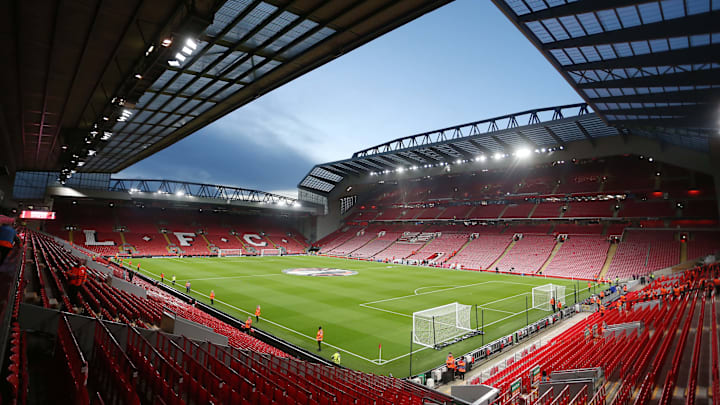It’s been 132 years since Liverpool became the major tenant of Anfield Stadium. As the home stadium for the club, Anfield, built in 1884, has etched itself into the hearts of most Kopites and Liverpool players.
Every time we hear the sounds from the waves of the crowd on each stand, it’s a significant sign to show that victory belongs to Anfield.
Despite its well-known existence around the football world, I guess most of us are still ambiguous about the meaning of Anfield. What does the name truly mean to the club and its loyal supporters? Let’s dive deeper.
For the Club: Memories of Expansions, Tragedies and Triumphs
Over the years, Anfield has undergone countless expansions to accommodate the growing number of Liverpool supporters.
Key developments include the construction of the iconic Spion Kop stand in 1906, the Main Stand expansion in 2016, and the ongoing Anfield Road End expansion in the 2023/24 season.
These renovations have not only increased capacity, but also enhanced the fan experience, marking a transcending success for the club over time.
No matter the bright and dark periods throughout the century, the stadium has witnessed tons of big memories.
The Hillsborough disaster in 1989 was a dark chapter in the club's history, costing 97 Kopites their lives and leading to significant changes in stadium safety standards.
On the opposite side, the stadium has also been the stage for numerous triumphs. After Bill Shankly took over the helm in 1959, Liverpool became a top-flight team in English football, including a series of league titles and European trophies.
Converting to Jürgen Klopp in the contemporary era, Liverpool fought back from its period in the doldrums of mediocrity and regained strength in European matches, including securing the Champions League title in 2019 and the long-awaited Premier League title in 2020.
The stadium has witnessed highs and lows, symbolizing the growing process of the club throughout its history, offering the club and the city some remarkable legacies to remember, and inheriting the spiritual messages to future Liverpool players and staff.
The Story of “This Is Anfield” Sign
It’s also noteworthy to mention that Shankly also introduced the “This is Anfield” sign in the player's tunnel in 1972, which not only instilled fear in the opponent but also motivated Liverpool players in every home match.
Now, we’ve seen some preeminent Liverpool players accustomed to touching the sign while making their way to the pitch, not only paying tribute to all Liverpool immortal precedents but also showing that they had earned the right to touch it as they helped the team win titles before.

One interesting story that made the sign go viral in 2009 is the “This is Anfield - So what?” statement from the head page of Marca.
Amidst Liverpool taking a 1-0 advantage to Real Madrid in the first leg of the quarter-final, the Spanish newspaper still satirized the team by utilizing the words from the sign.
Thus, the power of underestimating was inserted into Anfield in the second leg, where Liverpool slaughtered the opponent 4-0 as a response, forcing the outlet to eat its words.
For the Kopites: The 12th Man of the Pitch
As the club grew up through the centuries, Liverpool’s loyalty had emerged enormously. For most Liverpool supporters, Anfield is more than just a stadium.
They regard it as a place where passion, loyalty, and spirit converge. The club's ethos, You'll Never Walk Alone, is deeply ingrained in the fan culture, symbolizing the sense of family and unity when all Reds gather together at the stadium.
What the former manager Jürgen Klopp frequently praised is the significance of fans at Anfield who play a “12th man” role on the pitch.
Especially when the team encounters setbacks, fans’ passionate chants and songs always send out a message of encouragement, inspiring the team to find a way out of the difficulty.
Dating back to the Champions League Semifinal in 2019, while trailing 0-3 against Barcelona in the first leg, fans entered the stadium earlier and chanted before players showed up on the pitch.
Mo Salah, despite being ruled out from the second leg at Anfield due to the injury, gave a powerful response and appreciation to those fans by wearing a shirt with “Never Give Up” printed at the front.
We all know the later story, a historical comeback. But most Kopites would never forget when Klopp lined up all teammates in front of the stand and sang You Will Never Walk Alone with fans after the tremendous victory.

For those fans in any form of vulnerable state, watching a Liverpool match at Anfield may be one of their utmost dreams.
Thanks to the club’s solid commitment to local communities, Liverpool, with its foundation, provides matchday experiences to fans with backgrounds of disabilities, those from underdeveloped areas, or individuals who are going through difficult times, while working with local charities and community organizations to identify and reach out to these fans.
To surmise, there is only one Anfield. It's in a league of its own and always will be.
